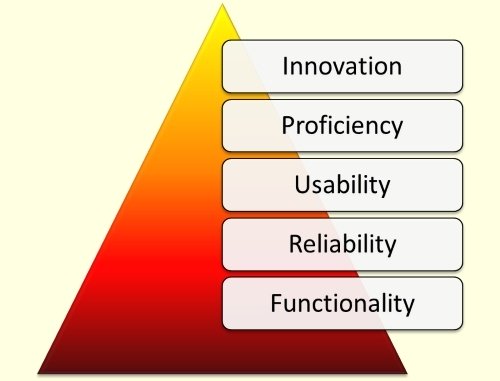As a small business matures, its systems and processes should also advance through several stages of improvement. Unfortunately, many small-business owners do not understand this evolutionary process and get stuck at the lower more primitive levels.
In his book, Universal Principles of Design, author William Lidwell states that “In order for a [system] design to be successful, it must meet people’s basic needs before it can satisfy higher-level needs.” (This concept comes from Maslow’s Hierarchy of Needs, which describes human motivation.)
High-Performance Systems
Most entrepreneurs begin with basic functioning business systems, often defined in the owner’s head. As the company expands, and people are added, systems and processes need to become more formalized to keep up. Increasing growth, competition, customer expectations, and daily challenges demand that business systems reach ever-higher levels of performance.
The Systems Thinker has an advantage. He or she understands the underlying principles of system development—process, components, people, quality, speed, and measurement. When these fundamental principles are applied, high-performance systems and processes evolve naturally.
Stages of System Evolution
Let’s take a quick look at the five stages of system evolution beginning at the bottom of the pyramid—the lowest need. Think about one of your important business systems.

- Functionality – Does your business system—lead generation, customer service, order fulfillment, and so forth—achieve its basic purpose? Rudimentary systems at this level are a good start. However, they are subject to frequent change, errors, waste, frustration, and breakdowns. They are nothing special, certainly no better than your competition (grade your business systems).
- Reliability – Is the performance of the system stable and consistent? This is a big improvement. Your process is now smooth-running and predictable. It operates without a lot of supervision. You may even think it is good enough.
- Usability – Is the system user-friendly, easy to operate, and forgiving of errors? Now you’ve designed a system that people enjoy working in. You’ve removed complexity, confusion, uncertainty, and even murmuring (see system busters). Employees perform better when they enjoy their work environment.
- Proficiency – Does the system empower people to do things not previously possible? Congratulations! You have a high-performance business system that delivers excellent quality and efficiency. It’s a money-maker. Your company is becoming exceptional!
- Innovation – Are your people now free to innovate and improve the business system or process? Is the system team at the top of their game, continually trying to achieve superior results, and better their best? Does this happen even if you’re not around? When enough of your business systems reach this level of performance, you will have a culture of excellence!
Developing effective business systems and processes does not happen overnight; however, you can accelerate the process if you understand the principles that drive improvement. Invest a little time every day in The Zone and push your core business systems and processes to the top of the pyramid.







